Infrared Image Adaptive Enhancement Guided by Energy of Gradient Transformation and Multiscale Image Fusion
Abstract
1. Introduction
2. Proposed Theory
2.1. EOG Guided Gray Distribution Adjustment
2.1.1. Energy of Gradient
2.1.2. EOG Guided Gray Distribution Adjustment
2.2. Multiscale Guided Filter Enhancement
2.2.1. Multiscale Guided Filter Decomposition
2.2.2. Adaptive Multiscale Guided Filter Composition
2.3. Image Fusion
2.4. Outliers Filtering
3. Experiment Results
3.1. Experimental Settings
3.2. Visual Comparisons
3.3. Quantitative Comparison
3.4. Running Time Comparison
4. Discussion
5. Conclusions
Author Contributions
Funding
Conflicts of Interest
References
- Sanchez-Reillo, R.; Tamer, S.; Lu, G.; Duta, N.; Keck, M. Histogram Equalization; Springer: New York, NY, USA, 2009. [Google Scholar]
- Song, Y.F.; Shao, X.P.; Xu, J. New enhancement algorithm for infrared image based on double plateaus histogram. Infrared Laser Eng. 2008, 2, 308–311. [Google Scholar]
- Vickers, V.E. Plateau equalization algorithm for real-time display of high-quality infrared imagery. Opt. Eng. 1996, 35, 1921. [Google Scholar] [CrossRef]
- Wang, B.J. A real-time contrast enhancement algorithm for infrared images based on plateau histogram. Acta Photonica Sin. 2006, 48, 77–82. [Google Scholar] [CrossRef]
- Zuiderveld, K. Contrast Limited Adaptive Histogram Equalization. In Graphics Gems; Academic Press Professional, Inc.: San Diego, CA, USA, 1994; pp. 474–485. [Google Scholar]
- Wan, M.; Gu, G.; Qian, W.; Ren, K.; Chen, Q.; Maldague, X. Infrared Image Enhancement Using Adaptive Histogram Partition and Brightness Correction. Remote Sens. 2018, 10, 682. [Google Scholar] [CrossRef]
- Liang, K.; Yong, M.; Yue, X.; Bo, Z.; Rui, W. A new adaptive contrast enhancement algorithm for infrared images based on double plateaus histogram equalization. Infrared Phys. Technol. 2012, 55, 309–315. [Google Scholar] [CrossRef]
- Kim, J.Y.; Kim, L.S.; Hwang, S.H. An advanced contrast enhancement using partially overlapped sub-block histogram equalization. IEEE Trans. Circuits Syst. Video Technol. 2001, 11, 475–484. [Google Scholar]
- Fattal, R.; Lischinski, D.; Werman, M. Gradient Domain High Dynamic Range Compression. ACM Trans. Graph. 2002, 21. [Google Scholar] [CrossRef]
- Zhang, F.; Xie, W.; Ma, G.; Qin, Q. High dynamic range compression and detail enhancement of infrared images in the gradient domain. Infrared Phys. Technol. 2014, 67, 441–454. [Google Scholar] [CrossRef]
- Durand, F.; Dorsey, J. Fast bilateral filtering for the display of high-dynamic-range images. ACM Trans. Graph. 2002, 21, 257–266. [Google Scholar] [CrossRef]
- He, K.; Sun, J.; Tang, X. Guided Image Filtering. IEEE Trans. Pattern Anal. Mach. Intell. 2013, 35, 1397–1409. [Google Scholar] [CrossRef]
- Li, S.; Kang, X.; Hu, J. Image Fusion With Guided Filtering. IEEE Trans. Image Process. 2013, 22, 2864–2875. [Google Scholar] [PubMed]
- Gu, B.; Li, W.; Zhu, M.; Wang, M. Local Edge-Preserving Multiscale Decomposition for High Dynamic Range Image Tone Mapping. IEEE Trans. Image Process. 2013, 22, 70–79. [Google Scholar]
- Bai, X.; Zhou, F.; Xue, B. Image enhancement using multi scale image features extracted by top-hat transform. Opt. Laser Technol. 2011, 44, 328–336. [Google Scholar] [CrossRef]
- Bai, X.; Zhou, F.; Xue, B. Infrared image enhancement through contrast enhancement by using multiscale new top-hat transform. Infrared Phys. Technol. 2011, 54, 61–69. [Google Scholar] [CrossRef]
- Zhan, B.; Wu, Y. Infrared Image Enhancement Based on Wavelet Transformation and Retinex. In Proceedings of the 2010 Second International Conference on Intelligent Human-machine Systems & Cybernetics, Nanjing, China, 26–28 August 2010. [Google Scholar]
- Mccann, J.J. Lightness and retinex theory. J. Opt. Soc. Am. 1970, 61, 1–11. [Google Scholar]
- Land, E.H. The Retinex Theory of Color Vision. Sci. Am. 1977, 237, 108–129. [Google Scholar] [CrossRef] [PubMed]
- Rahman, Z.U.; Jobson, D.J.; Woodell, G.A. Retinex processing for automatic image enhancement. J. Electron. Imaging 2004, 13, 100–110. [Google Scholar]
- Pu, Y.F.; Zhang, N.; Wang, Z.N.; Wang, J.; Yi, Z.; Wang, Y.; Zhou, J.L. Fractional-Order Retinex for Adaptive Contrast Enhancement of Under-Exposed Traffic Images. IEEE Intell. Transp. Syst. Mag. 2019. [Google Scholar] [CrossRef]
- Jobson, D.; Rahman, Z. Properties and performance of a center/surround retinex. IEEE Trans. Image Process. 1997, 6, 451–462. [Google Scholar] [CrossRef]
- Rahman, Z.; Jobson, D.J.; Woodell, G.A. Multi-scale retinex for color image enhancement. In Proceedings of the 3rd IEEE International Conference on Image Processing, Lausanne, Switzerland, 19 September 2002. [Google Scholar]
- Reinhard, E.; Stark, M.; Shirley, P.; Ferwerda, J. Photographic tone reproduction for digital images. ACM Trans. Graph. 2002, 21, 267–276. [Google Scholar] [CrossRef]
- Reinhard, E.; Pouli, T.; Kunkel, T.; Long, B.; Ballestad, A.; Damberg, G. Calibrated image appearance reproduction. ACM Trans. Graph. 2012, 31, 1–11. [Google Scholar] [CrossRef]
- Abebe, M.A.; Pouli, T.; Larabi, M.C.; Reinhard, E. Perceptual Lightness Modeling for High Dynamic Range Imaging. ACM Trans. Appl. Percept. 2017, 15, 1. [Google Scholar] [CrossRef]
- Ma, J.; Zhou, Z.; Wang, B.; Zong, H. Infrared and visible image fusion based on visual saliency map and weighted least square optimization. Infrared Phys. Technol. 2017, 82, 8–17. [Google Scholar] [CrossRef]
- Saeedi, J.; Faez, K. Infrared and visible image fusion using fuzzy logic and population-based optimization. Appl. Soft Comput. 2012, 12, 1041–1054. [Google Scholar] [CrossRef]
- Ma, K.; Zhou, W. Multi-exposure image fusion: A patch-wise approach. In Proceedings of the 2015 IEEE International Conference on Image Processing, Quebec City, QC, Canada, 27–30 September 2015. [Google Scholar]
- Ma, K.; Li, H.; Yong, H.; Wang, Z.; Meng, D.; Zhang, L. Robust Multi-Exposure Image Fusion: A Structural Patch Decomposition Approach. IEEE Trans. Image Process. 2017, 26, 2519–2532. [Google Scholar] [CrossRef] [PubMed]
- FLIR Thermal Starter Dataset Version 1.3. Available online: https://www.flir.com/oem/adas/adas-dataset-form/ (accessed on 16 August 2019).
- Berg, A.; Ahlberg, J.; Felsberg, M. A Thermal Object Tracking Benchmark. In Proceedings of the 2015 12th IEEE International Conference on Advanced Video and Signal Based Surveillance (AVSS), Karlsruhe, Germany, 25–28 August 2015. [Google Scholar]
- Tenenbaum, J.M. Accommodation in Computer Vision; Computer Science Department, Stanford University: Stanford, CA, USA, 1971. [Google Scholar]
- Mittal, A.; Soundararajan, R.; Bovik, A.C. Making a “completely blind” image quality analyzer. IEEE Signal Process. Lett. 2012, 20, 209–212. [Google Scholar] [CrossRef]
- Venkatanath, N.; Praneeth, D.; Bh, M.C.; Channappayya, S.S.; Medasani, S.S. Blind image quality evaluation using perception based features. In Proceedings of the 2015 Twenty First National Conference on Communications (NCC), Mumbai, India, 27 February–1 March 2015; pp. 1–6. [Google Scholar]

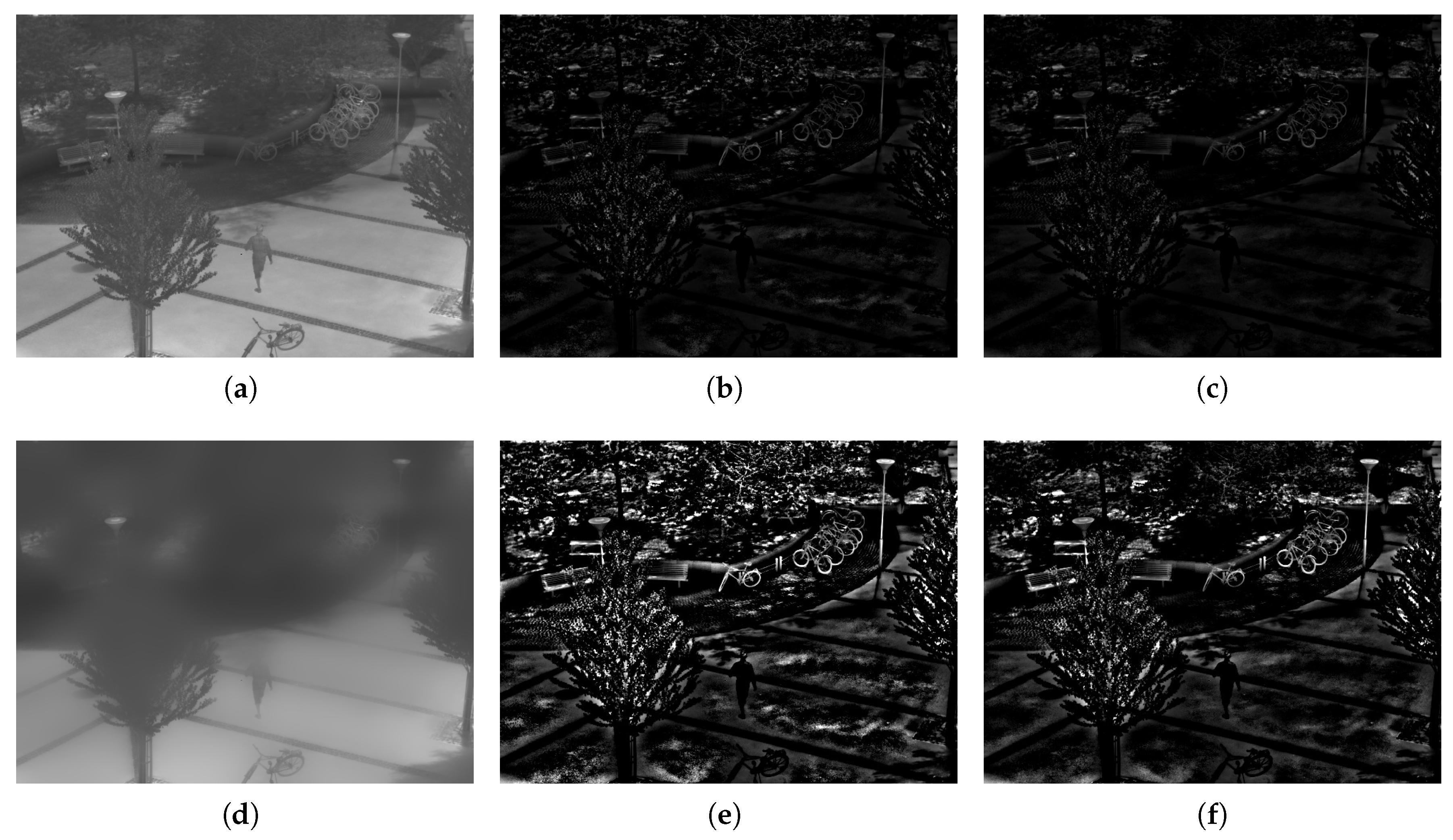

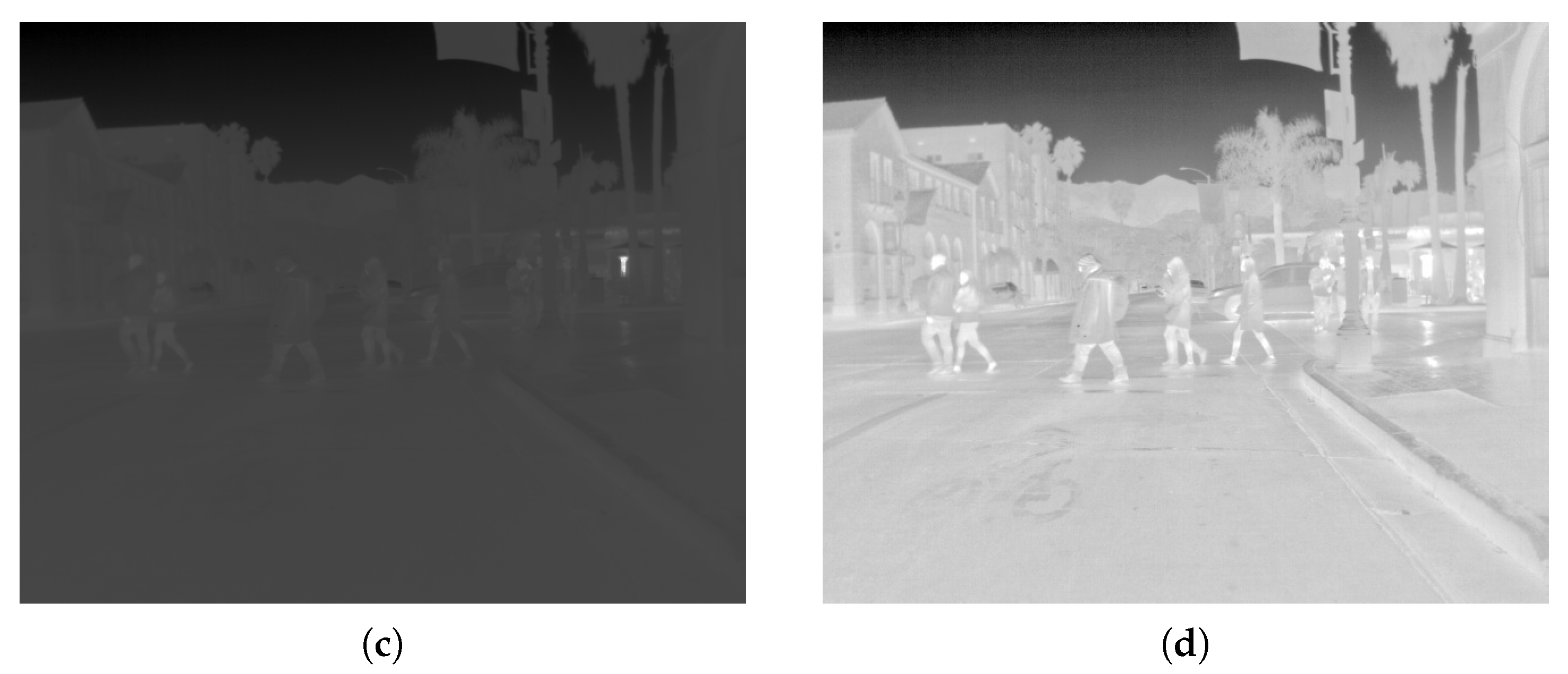
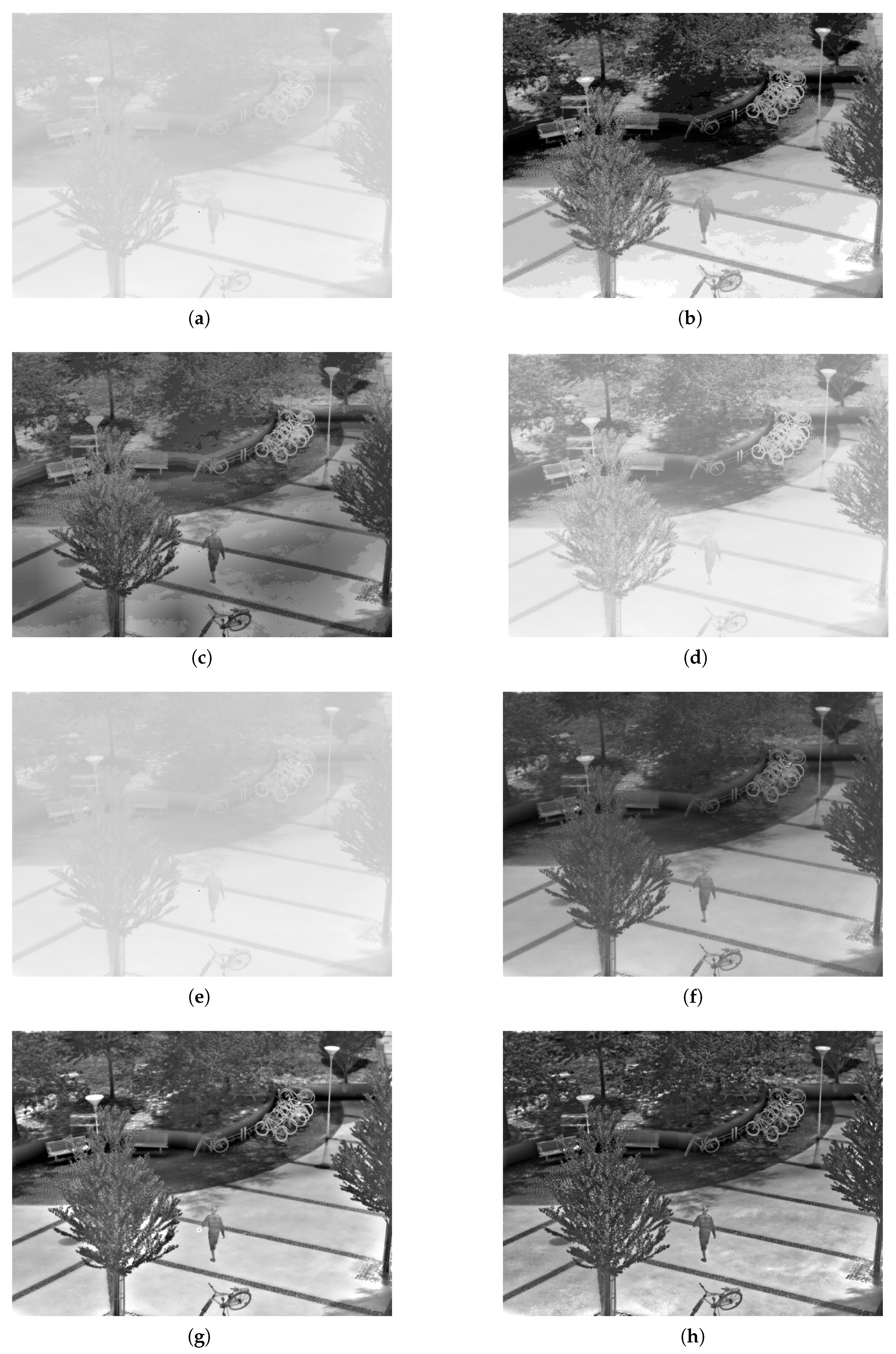
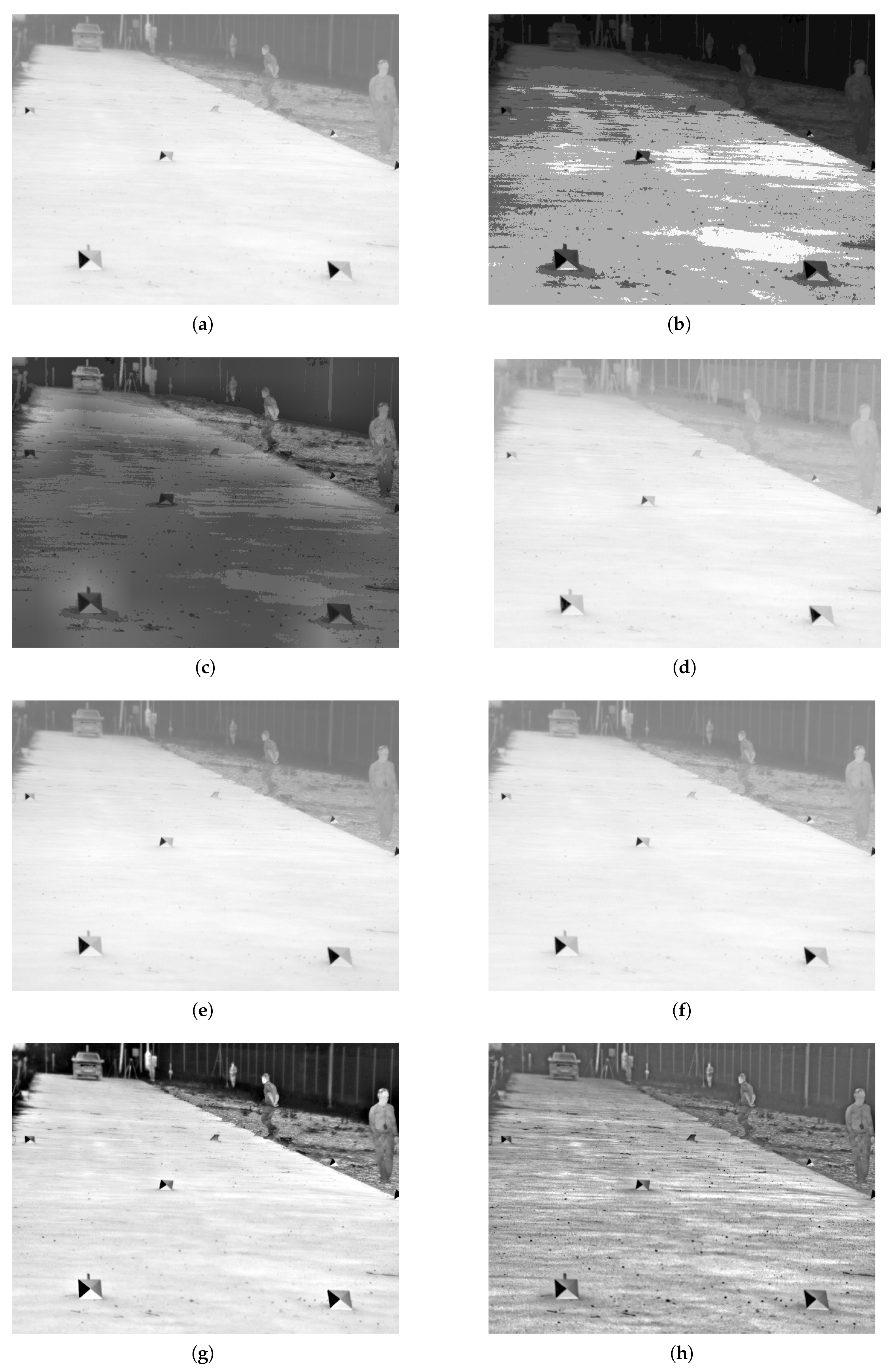
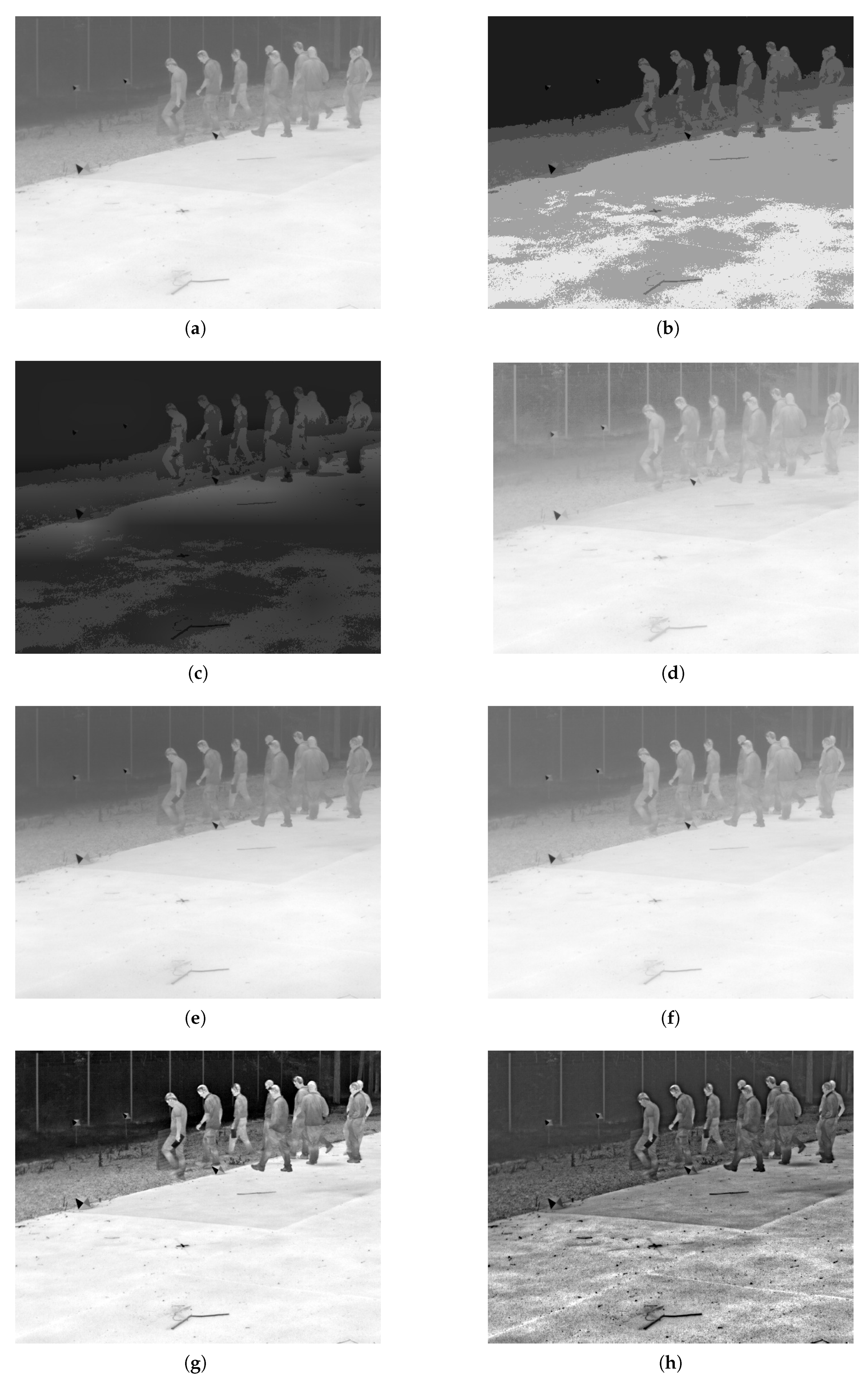
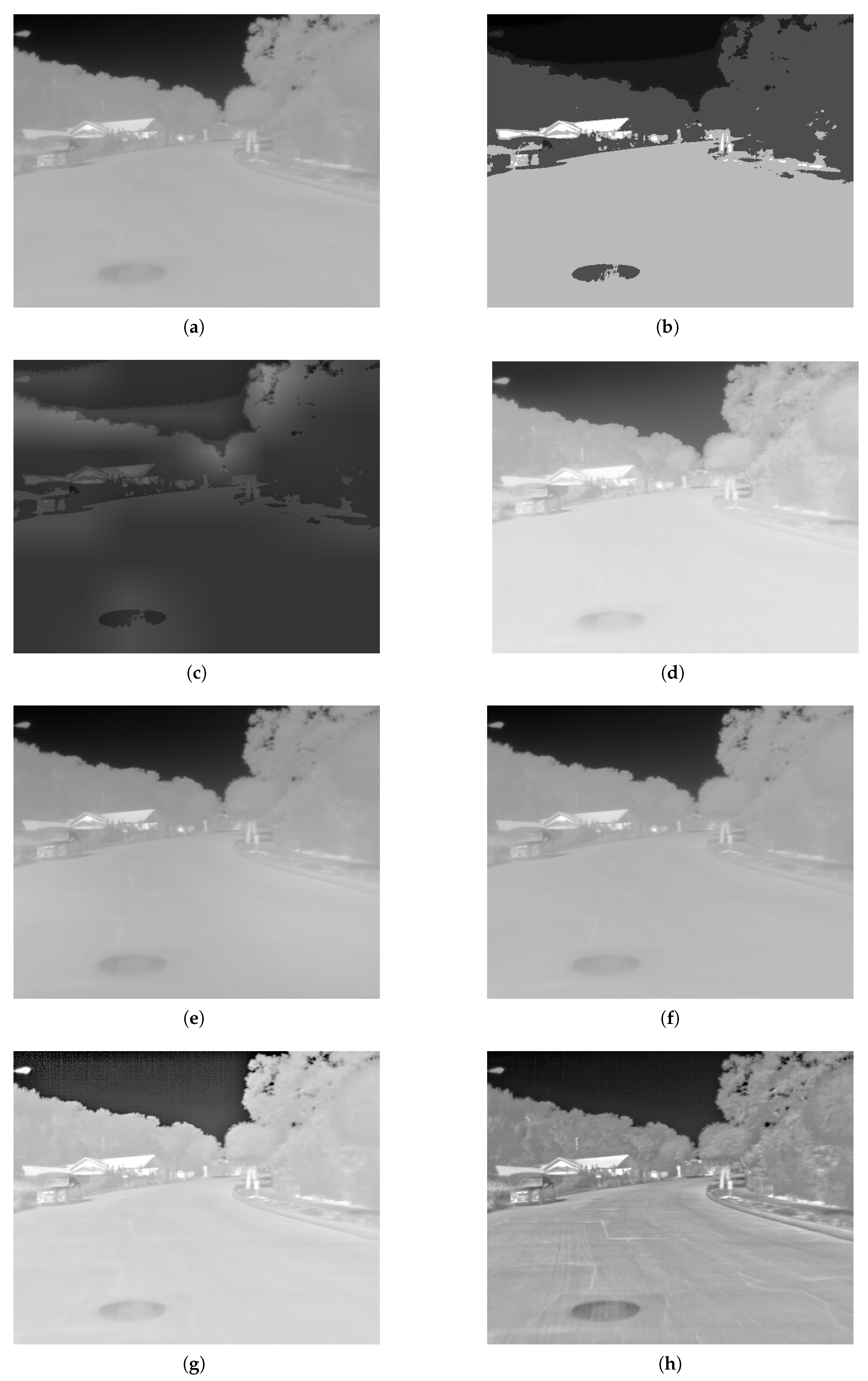

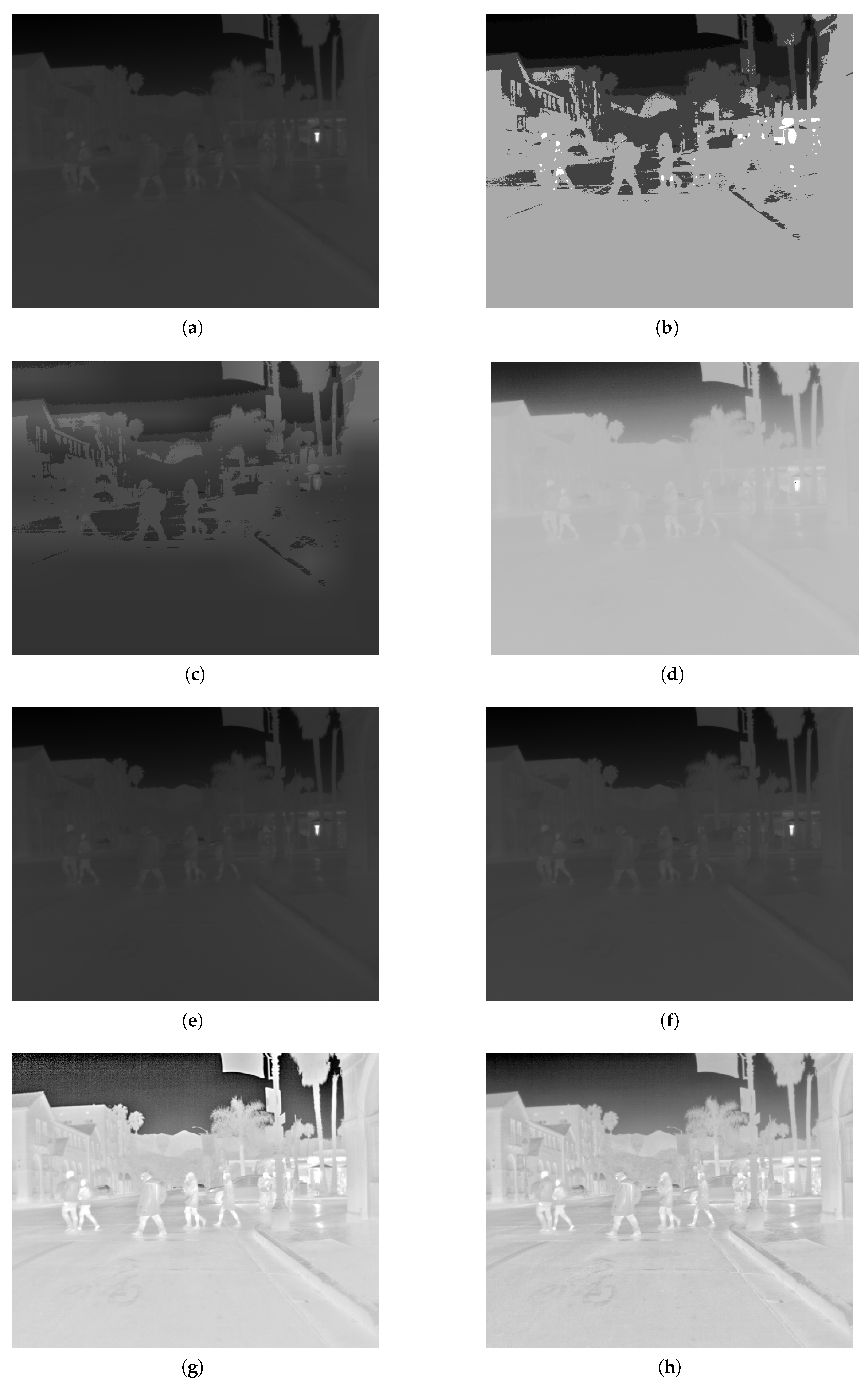
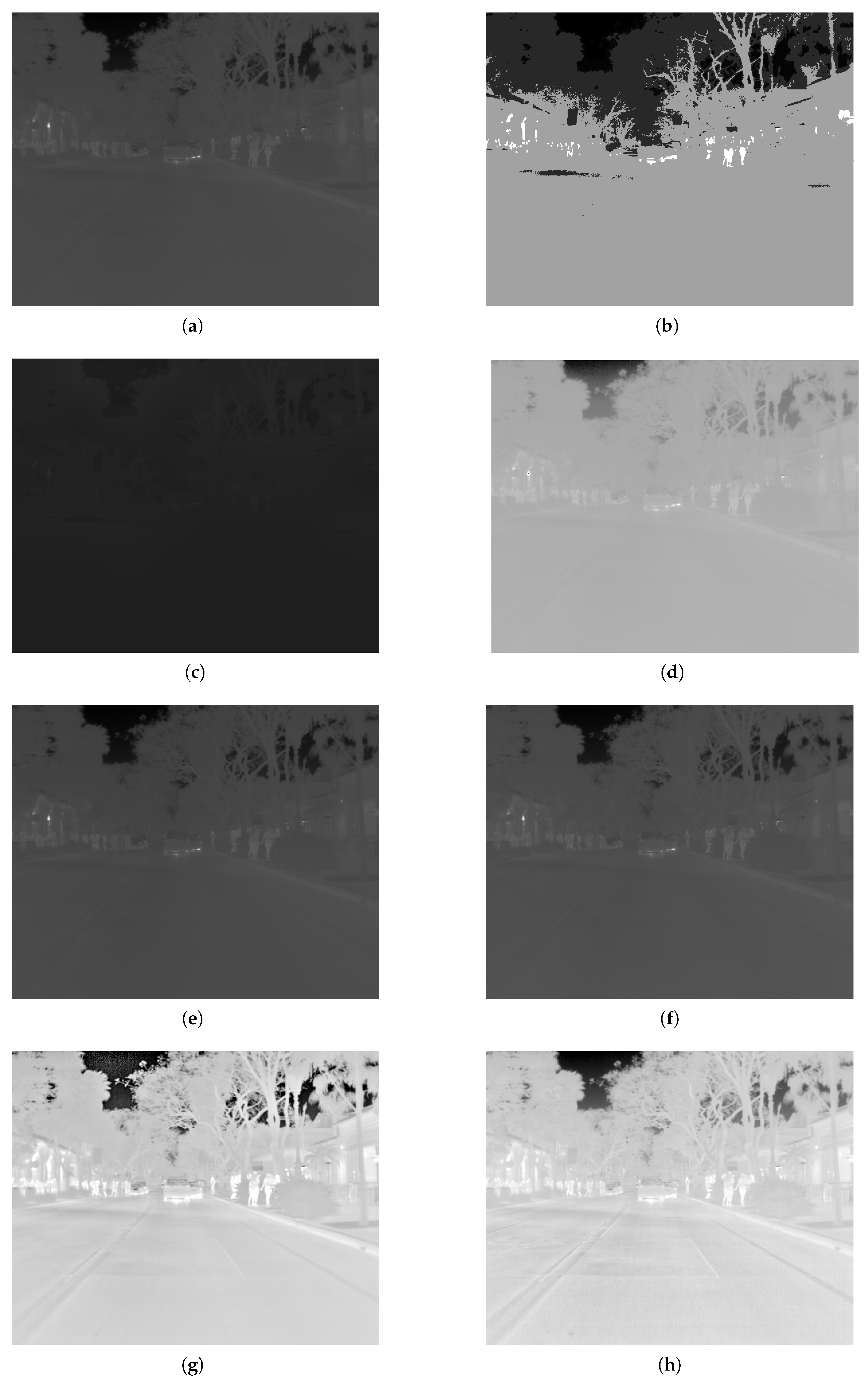
| Image | Size | Min (Gray Value) | Max (Gray Value) | % of the Total Gray Levels |
|---|---|---|---|---|
| IM1 | 480*640 | 0 | 16961 | 25.880 |
| IM2 | 480*640 | 9893 | 16339 | 9.835 |
| IM3 | 512*640 | 1411 | 3575 | 3.302 |
| IM4 | 512*640 | 5683 | 8188 | 3.822 |
| IM5 | 512*640 | 6433 | 8653 | 3.387 |
| IM6 | 512*640 | 5984 | 11322 | 8.145 |
| IM7 | 512*640 | 6010 | 10000 | 6.088 |
| Image | Linear Mapping | HE | CLAHE | AHPBC | MSR | Reinhard | LEP | Proposed |
|---|---|---|---|---|---|---|---|---|
| IM1 | 4.2562 | 18.8087 | 15.7123 | 10.5995 | 4.2137 | 11.1091 | 21.5385 | 22.3971 |
| IM2 | 4.9403 | 12.3800 | 7.4490 | 4.7770 | 4.8471 | 4.7601 | 11.1299 | 18.1054 |
| IM3 | 4.4459 | 8.9382 | 4.2856 | 4.7390 | 4.1821 | 4.2448 | 11.0855 | 18.5358 |
| IM4 | 3.1144 | 4.4115 | 2.0874 | 3.6231 | 3.1346 | 3.1205 | 5.9977 | 7.8913 |
| IM5 | 4.6191 | 5.1433 | 3.9676 | 4.6468 | 4.4070 | 4.6040 | 9.5314 | 14.9446 |
| IM6 | 1.4227 | 7.8863 | 2.9639 | 2.7526 | 1.4158 | 1.6008 | 8.4747 | 6.7918 |
| IM7 | 2.0778 | 8.7989 | 2.9121 | 2.9168 | 2.0738 | 2.2411 | 8.9327 | 6.8261 |
| Image | Linear Mapping | HE | CLAHE | AHPBC | MSR | Reinhard | LEP | Proposed |
|---|---|---|---|---|---|---|---|---|
| IM1 | 5.5735 | 3.4553 | 7.0238 | 5.3511 | 5.4562 | 7.3206 | 7.6118 | 7.5752 |
| IM2 | 5.7655 | 2.5542 | 6.5089 | 5.6805 | 6.0352 | 5.6525 | 6.7636 | 7.1654 |
| IM3 | 6.3733 | 2.2374 | 5.1676 | 6.1961 | 6.6940 | 6.2290 | 7.0587 | 7.4246 |
| IM4 | 5.9289 | 1.7727 | 5.1401 | 5.7168 | 6.4312 | 5.9052 | 5.8555 | 6.6476 |
| IM5 | 7.5017 | 2.8809 | 5.8623 | 7.4927 | 7.4540 | 7.5118 | 7.4614 | 7.8229 |
| IM6 | 4.5174 | 1.5771 | 5.2951 | 4.3780 | 4.7277 | 4.6765 | 6.1891 | 6.3499 |
| IM7 | 4.5504 | 1.1825 | 4.5859 | 4.5556 | 4.7223 | 4.6450 | 5.8029 | 5.8444 |
| Image | Linear Mapping | HE | CLAHE | AHPBC | MSR | Reinhard | LEP | Proposed |
|---|---|---|---|---|---|---|---|---|
| IM1 | 2.4030 | 7.6034 | 4.7557 | 2.3148 | 2.3713 | 2.1673 | 2.5625 | 2.8865 |
| IM2 | 3.1617 | 8.7744 | 5.8055 | 3.3352 | 3.2184 | 3.2078 | 3.4816 | 4.0588 |
| IM3 | 3.3359 | 11.5356 | 7.4972 | 3.8602 | 3.3382 | 3.2956 | 3.9761 | 4.3825 |
| IM4 | 7.5140 | 11.9366 | 7.5140 | 4.2840 | 4.8551 | 4.7213 | 4.2182 | 4.8106 |
| IM5 | 3.5719 | 15.0618 | 7.2863 | 3.4961 | 3.6931 | 3.6239 | 3.6369 | 3.4917 |
| IM6 | 4.9581 | 13.3283 | 7.4248 | 4.9065 | 4.8822 | 4.5561 | 3.9335 | 4.0222 |
| IM7 | 3.9773 | 11.7403 | 7.9685 | 3.7186 | 3.9794 | 3.8734 | 3.5809 | 3.5237 |
| Image | Linear Mapping | HE | CLAHE | AHPBC | MSR | Reinhard | LEP | Proposed |
|---|---|---|---|---|---|---|---|---|
| IM1 | 33.7017 | 65.3970 | 59.9335 | 33.43665 | 33.3354 | 21.2885 | 22.8901 | 24.9244 |
| IM2 | 30.8086 | 76.7303 | 74.3567 | 32.4350 | 32.8172 | 34.5472 | 20.3241 | 22.4031 |
| IM3 | 16.0431 | 82.7883 | 79.3746 | 16.5842 | 19.2051 | 18.4810 | 13.8669 | 30.9339 |
| IM4 | 74.8258 | 81.6471 | 74.8258 | 35.7224 | 37.2663 | 39.0461 | 36.4915 | 16.0016 |
| IM5 | 52.9848 | 82.5220 | 80.2671 | 52.7876 | 54.4075 | 49.0024 | 49.4377 | 43.2992 |
| IM6 | 65.9284 | 81.1321 | 77.7412 | 62.9356 | 64.9387 | 58.8325 | 20.6870 | 16.2914 |
| IM7 | 58.0052 | 79.8022 | 74.0387 | 56.8523 | 52.6654 | 54.8697 | 16.8590 | 16.2839 |
| Image | HE | CLAHE | AHPBC | MSR | Reinhard | LEP | Proposed |
|---|---|---|---|---|---|---|---|
| IM1 | 0.1140 | 0.1999 | 27.7791 | 0.9225 | 0.0257 | 0.8482 | 2.5096 |
| IM2 | 0.1195 | 0.1439 | 26.8293 | 0.1770 | 0.0284 | 1.0943 | 2.4500 |
| IM3 | 0.1111 | 0.1455 | 30.8719 | 0.1070 | 0.2198 | 1.1543 | 2.6872 |
| IM4 | 0.1158 | 0.1387 | 30.6425 | 0.1040 | 0.0202 | 1.1325 | 2.7946 |
| IM5 | 0.1253 | 0.1422 | 40.4624 | 0.0990 | 0.0207 | 1.0314 | 2.6288 |
| IM6 | 0.1112 | 0.1434 | 28.5309 | 0.0981 | 0.0208 | 1.2840 | 2.5608 |
| IM7 | 0.1463 | 0.1869 | 27.4465 | 0.9937 | 0.0203 | 2.1250 | 2.7588 |
© 2020 by the authors. Licensee MDPI, Basel, Switzerland. This article is an open access article distributed under the terms and conditions of the Creative Commons Attribution (CC BY) license (http://creativecommons.org/licenses/by/4.0/).
Share and Cite
Chen, F.; Zhang, J.; Cai, J.; Xu, T.; Lu, G.; Peng, X. Infrared Image Adaptive Enhancement Guided by Energy of Gradient Transformation and Multiscale Image Fusion. Appl. Sci. 2020, 10, 6262. https://doi.org/10.3390/app10186262
Chen F, Zhang J, Cai J, Xu T, Lu G, Peng X. Infrared Image Adaptive Enhancement Guided by Energy of Gradient Transformation and Multiscale Image Fusion. Applied Sciences. 2020; 10(18):6262. https://doi.org/10.3390/app10186262
Chicago/Turabian StyleChen, Feiran, Jianlin Zhang, Jingju Cai, Tao Xu, Gang Lu, and Xianrong Peng. 2020. "Infrared Image Adaptive Enhancement Guided by Energy of Gradient Transformation and Multiscale Image Fusion" Applied Sciences 10, no. 18: 6262. https://doi.org/10.3390/app10186262
APA StyleChen, F., Zhang, J., Cai, J., Xu, T., Lu, G., & Peng, X. (2020). Infrared Image Adaptive Enhancement Guided by Energy of Gradient Transformation and Multiscale Image Fusion. Applied Sciences, 10(18), 6262. https://doi.org/10.3390/app10186262




